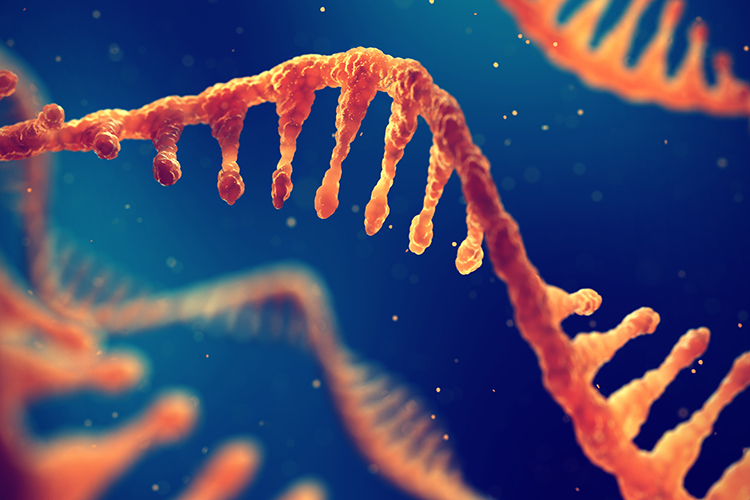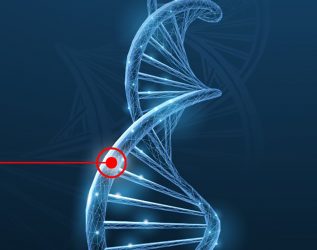Optimising analytical separations of synthetic RNA with modified HPLC
Posted: 21 April 2021 | Anastassia Kanavarioti (Yenos Analytical LLC), Sandra Rontree (Thermo Fisher Scientific) | No comments yet
Oligonucleotides are diverse in nature, with a wide range of applications. Here, Dr Anastassia Kanavarioti and Dr Sandra Rontree explore the challenges of oligonucleotide analysis in the life sciences sector and outline the different HPLC methods available for the job.


OLIGONUCLEOTIDES are the starting point for many molecular biology and synthetic biology applications. Used in a wide variety of ways, from biopharmaceutical therapeutics to clinical diagnostics and forensic research, the purification and analysis of oligonucleotides is becoming increasingly important across the life sciences sector.1
During the synthesis of oligonucleotides, smaller side chains, failure sequences and impurities can become present, which, depending on the downstream application, can negatively impact results. When choosing a technique to purify and characterise oligonucleotides, the type of solution being eluted and the goals of the analysis are both important. For example, if the downstream application requires only the full-length sequence, using a purification technique to create a purer oligonucleotide, such as high-performance liquid chromatography (HPLC), will be crucial.
However, many traditional analysis techniques can only process shorter chain oligonucleotides in a specific, high-resolution and high-purity manner. As many of the latest technologies, such as CRISPR, require longer scaffold sequences, there is a real need for advanced oligonucleotide purification and analysis.
Fortunately, the technologies available for DNA and RNA analysis are rapidly developing. Advances in HPLC instruments and innovative columns can improve resolution, accuracy and end sample purity. This facilitates precise knowledge of what a sample contains and enables the separation of a solution based on specific characteristics of a particular molecule. However, selecting the most appropriate method for your application is key. Here, we explore the challenges of oligonucleotide analysis and the different HPLC methods available.
Considerations for selecting the most appropriate technique
Within HPLC there are various options for oligonucleotide purification and analysis, including anion exchange (AEX) chromatography and ion‑pair reversed phase (IP-RP) chromatography. So, how do you know which method to select? The first step is to consider the goals of your analysis; for example, those interested in the molecular formula of an HPLC peak will require a different technique to those looking to understand the resolution of components in a mixture.


Optimising the resolution and selectivity of oligonucleotide analysis can be achieved using specifically designed columns for anion exchange (AEX) and ion-pair reversed phase (IP-RP) chromatography
Next, it is important to assess the specific challenges associated with analysing different kinds of oligonucleotides. For instance, synthetic oligonucleotides increasingly have chemical features that improve stability and bioavailability; these include the addition of phosphorothioate linkages, attachment of polyethylene glycol at the terminus and the incorporation of modified nucleosides. Where these chemical features are present, careful column selection and modifications to the purification technique are often required.2,3
The length of the oligonucleotide scaffold can also affect which HPLC technique will be the most appropriate. sgRNAs, for example, which are essential for CRISPR, tend to be 100 nucleotides long making their analysis difficult with traditional HPLC.4 Here, advanced HPLC systems will be required to ensure the accuracy of results and end sample purity. The need for such systems is also seen in diagnostics, where the identification of molecules, including long non-coding RNAs and oligonucleotides 20-300 nucleotides in length, is required.5
AEX and IP-RP chromatography can overcome many of the challenges associated with oligonucleotide analysis and purification – the two chemistries are complementary and each can be used to provide different information.
Anion exchange chromatography (AEX)
AEX is an example of an HPLC system suited to analyse short to long oligos as well as plasmid DNAs.4,6 Depending on the requirements of the analysis, different specifications of AEX column can be employed. For example, there are many columns available that vary in terms of resin type; pore size; and the temperature and pressure the system allows, providing great flexibility.
Traditionally, resin is functionalised using a quaternary or tertiary amine, which is positively charged. When the negatively charged oligonucleotide binds to the stationary phase, it elutes as the salt concentration increases. As oligonucleotide length increases, the more negative charge it has; therefore, longer oligonucleotides usually elute later. Changes are also seen in the elution, depending on the sequence and structure of the oligonucleotide.
The technologies available for DNA and RNA analysis are rapidly developing”
Variations in pH levels, particle size and the ability to operate at different temperature and pressure ranges also affect what can be achieved with a given AEX system. Particle size typically varies from 4-13μm, with 4μm giving ultra-high resolution, for instance, while high-throughput oligonucleotide separation can be achieved with high pressures of 10,000psi. Temperature and pH tolerances also vary widely, ranging from <35°C to 85°C and <8.5 to 12.5 respectively. By modulating pH, temperature, solvent and eluent salt, oligonucleotide retention and secondary structures can be controlled.
The ability to control these parameters makes AEX suitable for analysing both single- and double-stranded oligonucleotides. Notably, AEX is particularly effective for ultra high-resolution separation of components in a mixture.
Ion-pair reversed phase chromatography (IP-RP)
IP-RP is an alternative analytical strategy for RNA separation and is often used with organic solvents at high temperature. IP-RP can be used in conjunction with AEX with each method providing different information. Oligonucleotides have unique features that suit IP-RP. Each molecule contains one negative charge for each phosphodiester linkage when in aqueous solution above pH 4; this means traditional reversed phase chromatography is not suitable, while ion-exchange techniques such as IP-RP work well.7
It is important to assess the specific challenges associated with analysing different kinds of oligonucleotides”
However, retention and elution order are affected by the charge of the oligonucleotides, length of alkyl chain in the ion-pairing reagent and the proportion of organic solvent in the mobile phase.2 For example, the number of charges in the oligonucleotides increases the retention time, as does increased hydrophobicity in the ion-pairing agent long alkyl chain.8
Optimising the resolution and selectivity of the column can be achieved by altering the mobile phase.9 The most commonly used ion-pair reagent is triethylammine (TEAA) but other ion-pair reagents could provide alternative selectivity. For example, tetrabutylammonium bromide (TBAB) as an ion-pairing agent can improve separation,2 while using hexafluoro-2-propanol (HFIP) in the mobile phase makes the system compatible with mass spectrometry, enabling molecular weight determination.
IP-RP systems can often be modulated to allow separation of different molecules; for example, different ion-pair reagents could be used to gain optimal separation for specific samples. Additionally, some IP-RP systems use polymer resin, as opposed to silica. This gives excellent stability at high temperatures (up to 100°C) and supports high pH (0-14 pH range), giving the freedom to operate in conditions required for high selectivity and resolution. Large pore IP-RP systems can also be used, allowing long oligonucleotides to diffuse in and out to generate sharper peaks than a small-pore system.
In short, novel IP-RP technology can resolve both very small and very large oligonucleotides and can be compatible with mass spectrometry, a great benefit if determining the compound identity.
Better results with better tools
Effective and reliable oligonucleotide analysis and purification is critical for many life science applications. Traditional analytical methods are unreliable for processing the longer scaffold sequences often required by the latest technologies such as CRISPR. Making use of the latest analytical systems that can work with longer sequences, such as AEX and IP-RP, is key to avoid these downstream applications being compromised.
By considering the goals and requirements of your specific analysis needs and selecting the most appropriate method, you will be able to generate accurate and reproducible results and ensure end sample purity.
About the authors


Dr Anastassia Kanavarioti has 40 years’ experience using HPLC analysis with a wide range of chemical entities. She has used HPLC analysis to elucidate mechanisms of reactions, to assess purity and stability of pharmaceutical preparations and in support of formulation development. Her primary focus is oligonucleotide separations and profiling of oligonucleotide mixtures. She founded Yenos Analytical LLC in 2013 and is currently using HPLC to validate nanopore devices as analytical sensors for microRNAs in biological fluids. Tessi has over 60 peer‑reviewed publications showcasing HPLC methods that successfully address separation and mechanistic questions.


Dr Sandra Rontree is a product marketing manager for chromatography columns and consumables in the Chromatography and Mass Spectrometry group at Thermo Fisher Scientific. Sandra has more than 20 years’ experience with analytical instrumentation and has a strong interest in UHPLC, mass spectrometry and the life sciences.
References
- Sun H, Zhu X, Lu PY, et al. Oligonucleotide aptamers: New tools for targeted cancer therapy. Mol Ther Nucleic Acids 2014;3:182.
- Gilar M. Analysis and purification of synthetic oligonucleotides by reversed-phase high-performance liquid chromatography with photodiode array and mass spectrometry detection. Biochem 2001;298:196–206
- Abeydeera ND, Egli M, Cox N, Yang YB. Evoking picomolar binding in RNA by a single phosphorodithioate linkage. Nucleic Acids Res 2016;44:8052–8064
- Kanavarioti A. HPLC methods for purity evaluation of man-made single-stranded RNAs. Scientific Reports 2019;9(1019).
- Kang ASW, Bernasconi JG, Jack W, Kanavarioti A. Ready-to-use nanopore platform for the detection of any DNA/RNA oligo at attomole range using an Osmium tagging complementary probe. Scientific Reports 2020;10(19790).
- Thayer JR, McCormick RM, Avdalovic N. High-resolution nucleic acid separations by high-performance liquid chromatography. Methods Enzymol 1996;271:147-74.
- Biba M, Mao B, Welch CJ. Liquid chromatography methods for the separation of short RNA oligonucleotides. LCGC N Am. 2014;32:42–50
- Zhang Q, Lv H, Wang L, et al. Recent methods for purification and structure determination of oligonucleotides. International Journal of Molecular Sciences; 2016:17(2134)
- Andrus A, Bloch W. HPLC of oligonucleotides and polynucleotides. HPLC Macromol 1998; 872:141
Issue
Related topics
Analytical techniques, Biopharmaceuticals, Chromatography, HPLC, Sequencing, Technology, Therapeutics









